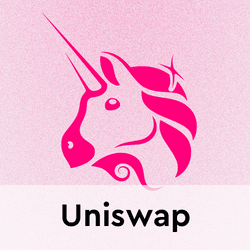This report explores the most significant metaverse trends that are likely to have an impact on the future of the blockchain industry.
Disclaimer: DappRadar tracks the number of Unique Active Wallets (UAW) that interact with the smart contracts associated with a decentralized application (dapp) over a period of time. This is also known as on-chain or blockchain activity. However, multiple dapps do not require executing a blockchain transaction to perform certain actions.
The activity outside a blockchain ecosystem is called off-chain or Web 2.0 activity. Off-chain activity is traditionally measured by the number of Daily Active Users (DAU). An example of off-chain activity is a user visiting the virtual world of The Sandbox or Decentraland or a user who plays Axie Infinity without claiming rewards and thus executing a blockchain transaction.
The Web3 metaverse allows a reset that could solve certain well-known issues with the Web2 internet, such as data mining and concentration of power. It is a revolutionary, decentralized architecture that uses blockchain technology to link virtual worlds with new money and assets.
This paradigm allows producers and users a greater part of the benefits of virtual worlds than the internet does now. In 2021 alone, blockchain companies associated with the metaverse raised more than $4 billion to make this future happen.
On the other side, numerous critics believe the Web3 vision is illusory. Critics claim this vision is merely hype and susceptible to fraud, with a grim future given the technical and regulatory obstacles it faces. They frequently anticipate a future metaverse based on centrally-owned platforms, such as those currently dominating the online gaming industry.
These proponents continue to believe in the utility of virtual commodities and virtual worlds, but are cautious of completely interoperable goods such as NFTs and blockchain-based virtual worlds.
The metaverse can be understood from two distinct perspectives: the classical metaverse and the metaverse based on blockchain technology. The former can be related to Web2 concepts, a hybrid notion in which the present game and social experiences are fused with online augmented reality. The blockchain metaverse, on the other hand, adheres to Web3 ideas and empowers individuals via blockchain technologies.
Due to the power of non-fungible tokens (NFTs) in the blockchain-based metaverse, anyone can own and employ virtual assets according to their requirements and preferences. NFTs are unique tokens that reside on the blockchain and confer ownership rights over the digital asset on their holders. This is most likely the greatest advantage of the blockchain metaverse.
Virtual real estate NFTs are the most interesting part of the blockchain metaverse. These digital parcels of land combined constitute a blockchain virtual world (BVW) or 3D virtual environment. These digital parcels allow owners to construct, encouraging creativity and decentralization.
Platforms like Decentraland, CryptoVoxels, and Somnium Space are moving toward becoming social platforms. At the same time, spaces like The Sandbox, Treeverse, and Ember Sword are play-to-earn games with virtual real estate features. However, each platform has traits that distinguish them from one another.
This report aims to cover what happened in the last quarter in the metaverse, and analyze the on-chain metrics of the most popular metaverse projects.
Key Takeaways
- Virtual worlds trading volume dropped 91.61% to $90 million in Q3. The number of land sales decreased 37.54% quarter-over-quarter, indicating that the enthusiasm for these types of projects hasn’t faded as much.
- The trading volume of the top 10 metaverse projects has decreased by 80% on average from Q2, but the sales count decreased only 11% on average.
- In September, only 0.7% of Decentraland’s more than 97,000 properties were listed and sold, despite 1.48 buyers for every land seller.
- The Sandbox Alpha Season 3 hosted over 90 experiences, with 4 million people registered with a wallet, and over 200,000 monthly active users. This helped the platform increase its sales count by 190% from the previous quarter.
- Metaverse-based tokens lost on average 60% of their value amid economic uncertainty.
- In Q3 more than 1.12 million ENS domain names were registered, an increase of 72% from Q2.
- 33% of the $1.2 billion raised in Q3 is directed towards building the metaverse infrastructure
- Beijing’s municipal administration has proposed a two-year metaverse innovation and development strategy to help the city become a digital economy benchmark.
Contents
Virtual worlds overview
After the hype experienced in May around the Otherside mint, virtual world projects had a calmer quarter. The category’s trading volume decreased by 91.61% from the $893 million generated the previous quarter. On the other hand, the number of land transactions declined by 37.54% from the previous quarter to 52,224, indicating that the excitement surrounding these types of projects has not subsided but is approaching a consolidation period.
![Metaverse Report #2: Demand for Metaverse Remains Amidst Crypto Turmoil Virtual_World_Trading_Volume_and_Sales_Count[1]](https://platoblockchain.com/wp-content/uploads/2022/10/dappradar.com-virtual-world-trading-volume-and-sales-count1.png)
Leading metaverse projects showed sustained blockchain activity in Q3
The UAW or user data is the ‘number of unique wallet addresses interacting with a dapp’s smart contracts’. So, to be counted by DappRadar, a wallet must make a blockchain transaction.
Otherdeed for Otherside was the most prevalent metaverse project in May 2022, after one of the largest mint events in NFT history. However, The Sandbox and Decentraland remained among the most active metaverse platforms throughout the year.
Since May, The Sandbox has maintained an average of 750 daily wallets interacting with the gaming platform’s contracts. In contrast, The Sandbox Marketplace, the dapp where the game’s NFT assets are traded, has been on an upward trend since May. The Sandbox Marketplace has seen an uptick in its daily UAW of 348%, reaching 395 in September.
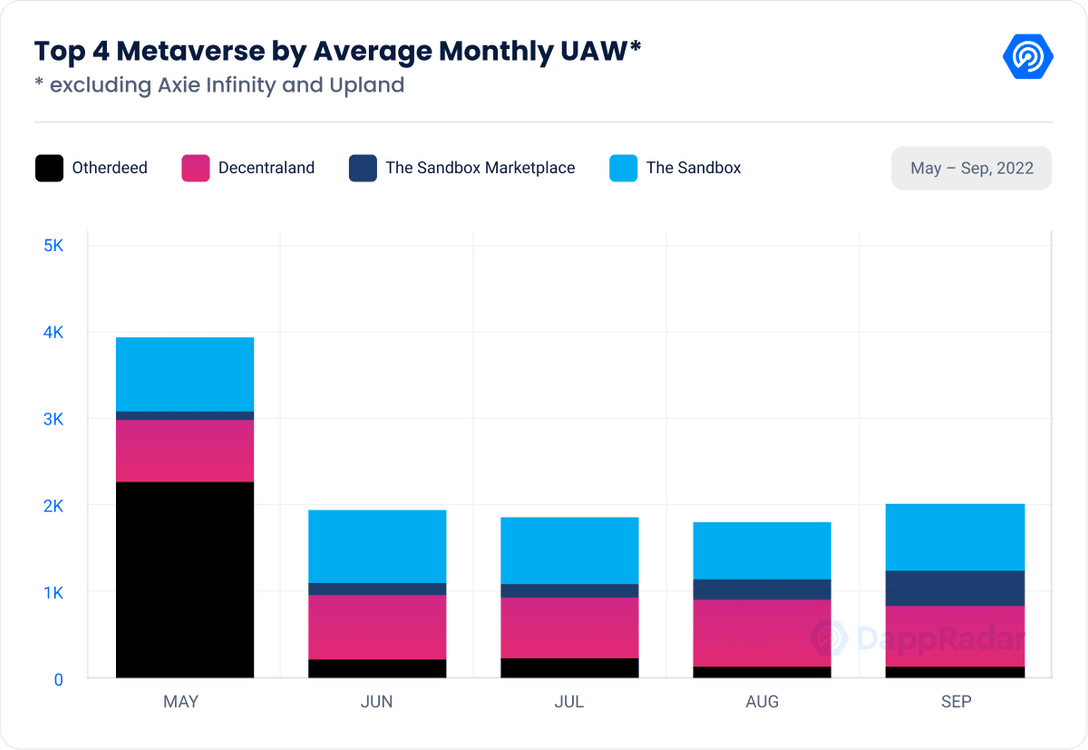

Similarly, Decentraland maintained constant blockchain activity for the past five months. Thanks to Pride Week in June, and Art Week in August, Decentraland has attracted an average of 792 daily users since May.
Despite the economic uncertainty that the markets currently face, the interest in metaverse platforms keeps consolidating at growing rates.
The USD trade volume of the biggest metaverse projects dropped 80% this quarter
Suffering from the harsh macro environment, the USD trading volume for 10 of the top metaverse projects (excluding Axie and Upland) decreased 80% on average this quarter.
Otherdeeds for Otherside amassed $54 million in trading volume in Q3, a decline of 92.70% compared to the second quarter. Nevertheless, the Yuga Labs gaming virtual world hosted key events. In July, the project gathered 4,300 testers, “Voyagers,” for a tech presentation and tour of the metaverse developed by Improbable. The team rolled out a couple of load tests to stress Improbable high-end metaverse technology M2.
Also in August, Eminem and Snoop Dogg performed at the annual Music Video Awards in the Otherside metaverse. Otherside accounts for 73.98% of the overall virtual world trading volume in the third quarter.
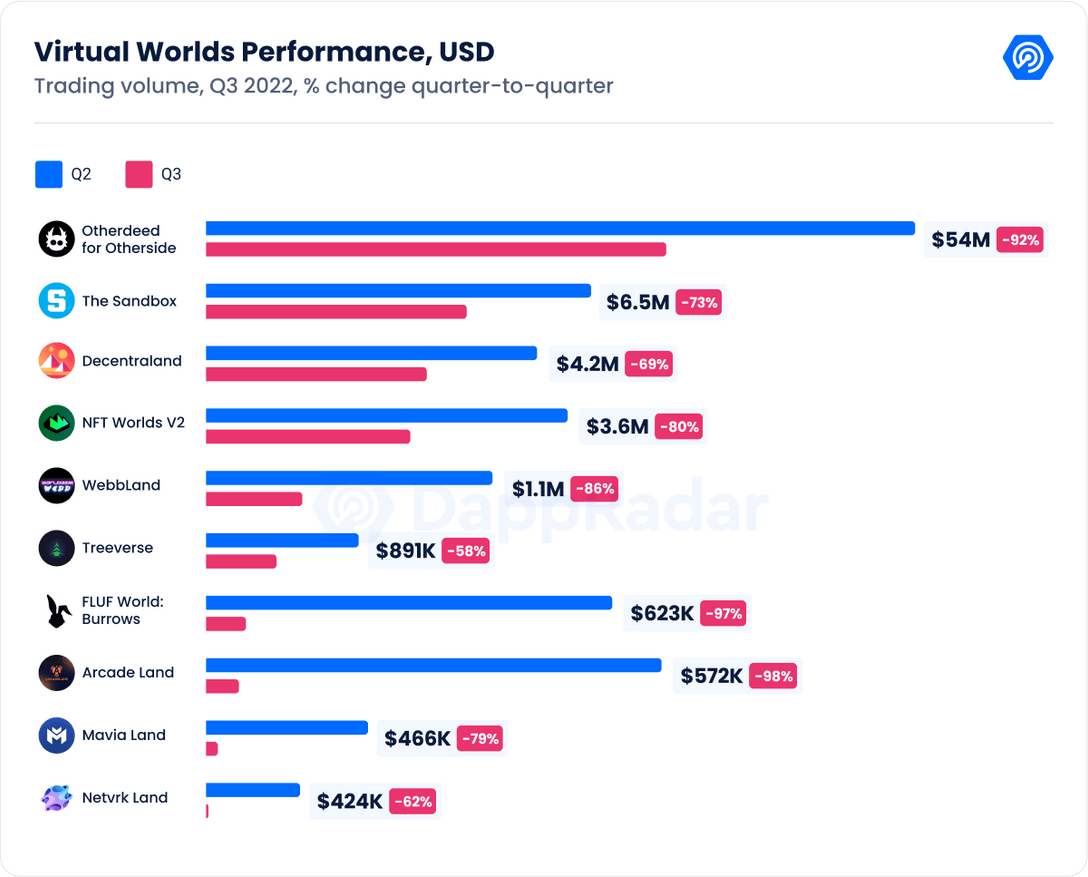

NFT Worlds also experienced an interesting quarter. The collection’s trading volume fell by 80.62% to $3.6 million, the lowest month ever for this project. This decline is a result of Minecraft’s July prohibition on NFTs. NFT Worlds was leveraging Minecraft’s source code as a basis for its NFT-powered metaverse project. However, Minecraft stopped supporting this integration.
Treeverse, another gaming metaverse, is down 58% from Q2, and for the first time, the third quarter trading volume was below $1 million, or $891,175 to be precise. It is the lowest trading volume ever recorded for Loopify’s game. Despite the low metrics, the project announced the pre-alpha of their game would be live before the end of the year.
While most metaverse projects endured a lull, The Sandbox’s trading volume increased by 25.69% in September, albeit they are still down 73.20% from the second quarter.
Netvrk Land has also witnessed a growth of 54.16% ($173K) from the previous month, although the company is still down 62.34% from the second quarter. Netvrk Land concludes the quarter with a trading volume below $500,000 for the first time ever, its lowest trading volume ever recorded.
The demand for metaverse projects is still high, with only 11.55% decrease in sales count from Q3
In Q3, the sales count of the top 10 metaverse projects decreased on average by 11.55%. We consider this a bullish sign because it shows that the hype for these types of projects hasn’t decreased. Instead, the fall of cryptocurrency prices has affected the projects’ overall trading volume instead of a lack of interest.
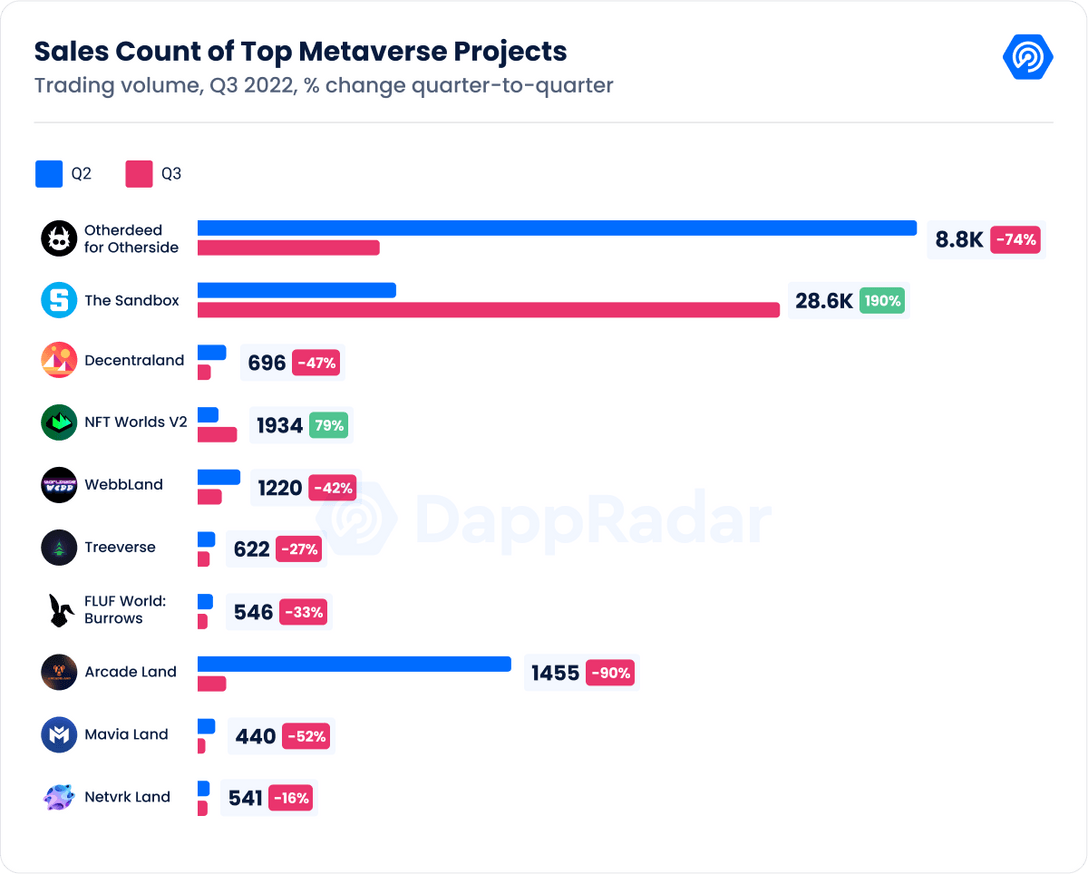

Otherdeed for Otherside had a 74% decrease in sales count in Q3, compared to Q2. Similarly, Decentraland had a similar decrease, and from Q2 it fell by 47%, reaching 696 sales in Q3.
On the other hand, the sales count for The Sandbox increased by 190% from Q2, reaching 28,624, mainly driven by the Alpha Season 3. Similarly, NFT Worlds had a 79% increase in sales count from Q2, driven by the Minecraft ban as some holders looked to cut losses while others saw the situation as a buying opportunity.
This quarter FLUF World: Burrows experienced a decline of 33% in sales numbers when compared to Q2. Still, this quarter has been busy for the platform. In July, the metaverse project announced the launch of The Futureverse Foundation, a charitable foundation with artist Alexandra Grant and actor Keanu Reeves as its advisors. The organization will fund marginalized artists and exhibit their work on both digital and physical channels. Special consideration will be given to indigenous and female artists in the selection of grant recipients.
The floor price of virtual lands in USD decrease 75% this quarter
Currently, metaverse real estate values are near a one-year low. Still, even though purchasing and reselling land is not profitable at the moment, there are sufficient opportunities for metaverse landlords and developers.
While the value of any piece of real estate, virtual or otherwise, is subject to swings, metaverse real estate is currently very depreciated. This comes mostly from the massive price drops in the cryptocurrency markets. Because virtual land is obtained using cryptocurrency, the value of virtual real estate is heavily influenced by cryptocurrency price swings.
On September 30th, the floor price of land in Otherdeed for Otherside was 1.62 ETH ($2,593), 66.60% down from the end of May.
Similarly, the price of land in The Sandbox and Decentrand dropped by 41.44% in USD ($2,317.08) and 56.05% ($2,315) from May 1st, respectively. But, if we look at the ETH price of The Sandbox, we can observe that it actually increased by 2.90% (1.49 ETH / 3109 SAND)
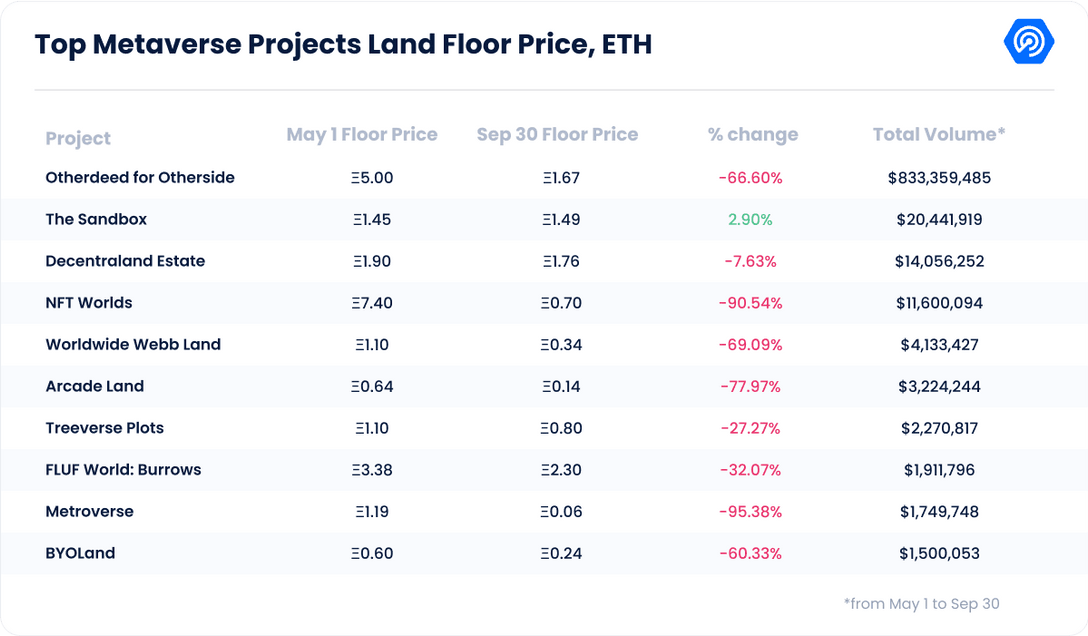

The floor price of NFT Worlds dropped by 90% in the same time, with a drastic decrease following the Minecraft ban. NFT Worlds’ floor at the end of September was 0.7 ETH ($909).
Even with a restricted supply of usable land, metaverse purchase prices have been low for months. In September, for instance, just 0.7% of the more than 97,000 properties in Decentraland were listed and sold, even though there were 1.48 purchasers for every land seller. This scenario has made it extremely difficult for speculators to flip assets but has benefited those with a long-term view of what the metaverse may become. These individuals are exploring methods to lease their homes to companies interested in establishing a metaverse presence without requiring an immediate purchase.
HSBC, DBS Bank, and Atari have announced new initiatives in The Sandbox, while Schneider Electric, Pepperidge Farm, and United Parcel Service have recently debuted in Decentraland.
Real estate in the metaverse may appear to be a risky investment. Still, it has been a reliable source of income for many in the past year as companies increasingly discover they require assistance developing virtual environments that will appeal to potential consumers and users.
Decentraland welcomed 56,000 daily users in September
Launched in early 2020, Decentraland remains one of the leading blockchain-based metaverse projects. As mentioned before, the social-oriented metaverse successfully hosted Pride Week in June and Art Week in August, with a Music Festival in November.
In September, Decentraland held over 160 community events, including a metaverse fashion event organized by RLTY, The Fabricant, and World of Women (WoW). The event’s primary objective was to draw women and fashion into the metaverse. The three-day festival occurred on “Synth Avenue” in Decentraland, a location created for the occasion. The neighborhood was developed by RLTY and was modeled after New York’s iconic Fashion Avenue.
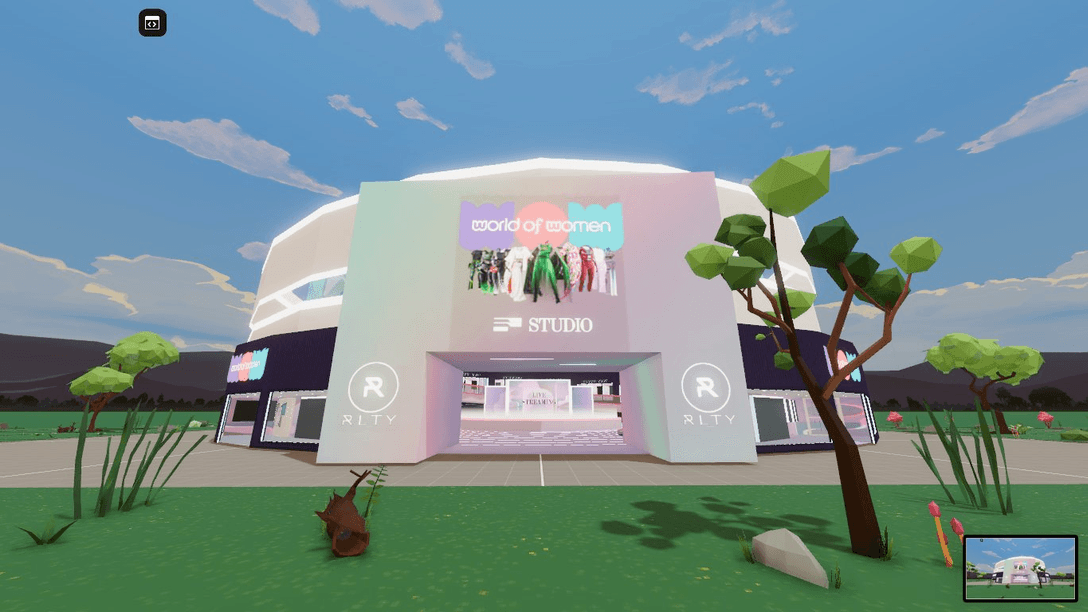

The September events attracted 56,000 daily active users (DAU) to Decentraland’s virtual parcels, an increase of 6% from August. The blockchain activity measured by UAW also paints a bullish outlook for the virtual world, as almost 800 unique wallets interact daily with Decentraland’s contracts, including meta-transactions.
For reference, a meta-transaction is a blockchain transaction signed by a user and sent to a third party called a relayer to execute it and, thus, pay the gas fee. The Decentraland Foundation sponsors a relayer to allow users to interact with Web3 without the burden of gas fees. Also, since Decentraland runs on multiple networks (Ethereum and Polygon), meta-transactions improve the user experience by allowing users to sign transactions in Ethereum that end up as transactions relayed on Polygon. Since a single relayer executes meta-transactions, these do not count as Unique Active Wallets.
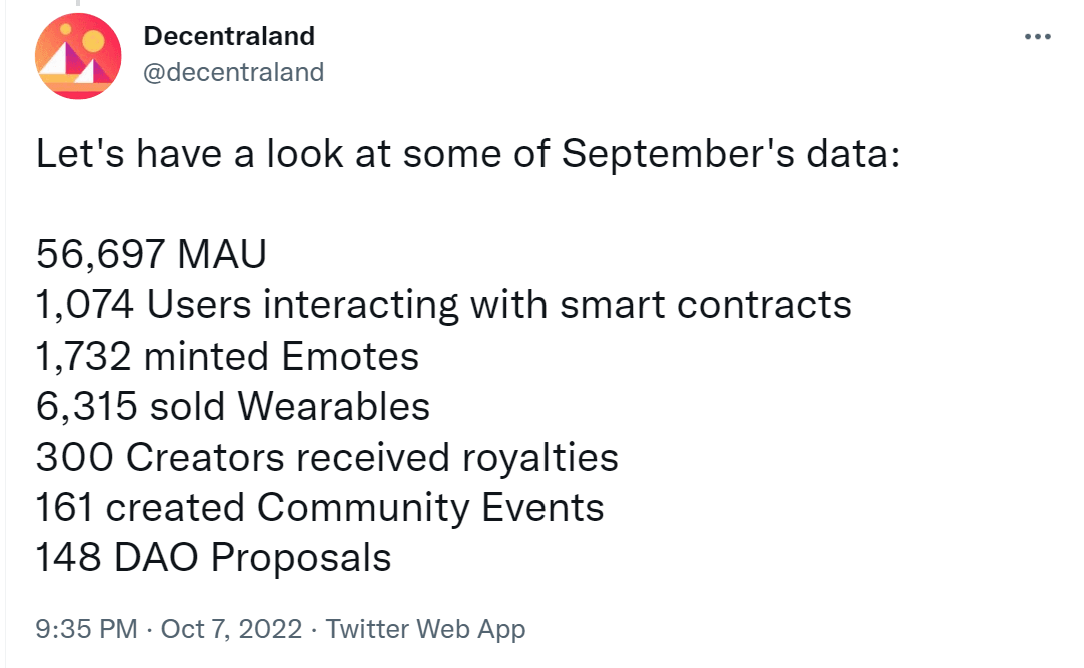

Another aspect worth noting is Decentraland’s governance metrics. While the usage metrics tell one side of the story, Web3 projects should also be scrutinized under the decentralization scope. The nearly-150 DAO proposals that received over 11,000 votes in September show that the project’s community is engaged. A DAO entails one of the critical aspects of many Web3 projects that aims for true decentralization. In Decentraland’s case, it shows the project’s health and potential.
The Sandbox Alpha Season 3 attracts 200,000 active users
The Sandbox has announced that Alpha Season 3 has reached 200,000 monthly participants, marking a significant milestone for the gaming platform. The Alpha Season 3 showed that The Sandbox can deliver an impressive metaverse experience, combining different projects and communities into one playful event.
In addition, they reported that 39,000 users browse the virtual world daily, with 1.6 million visitors visiting The Sandbox website in the past month alone.
As if that wasn’t enough evidence of The Sandbox’s growing popularity, Season 3 has been played for a total of 1.6 million hours.
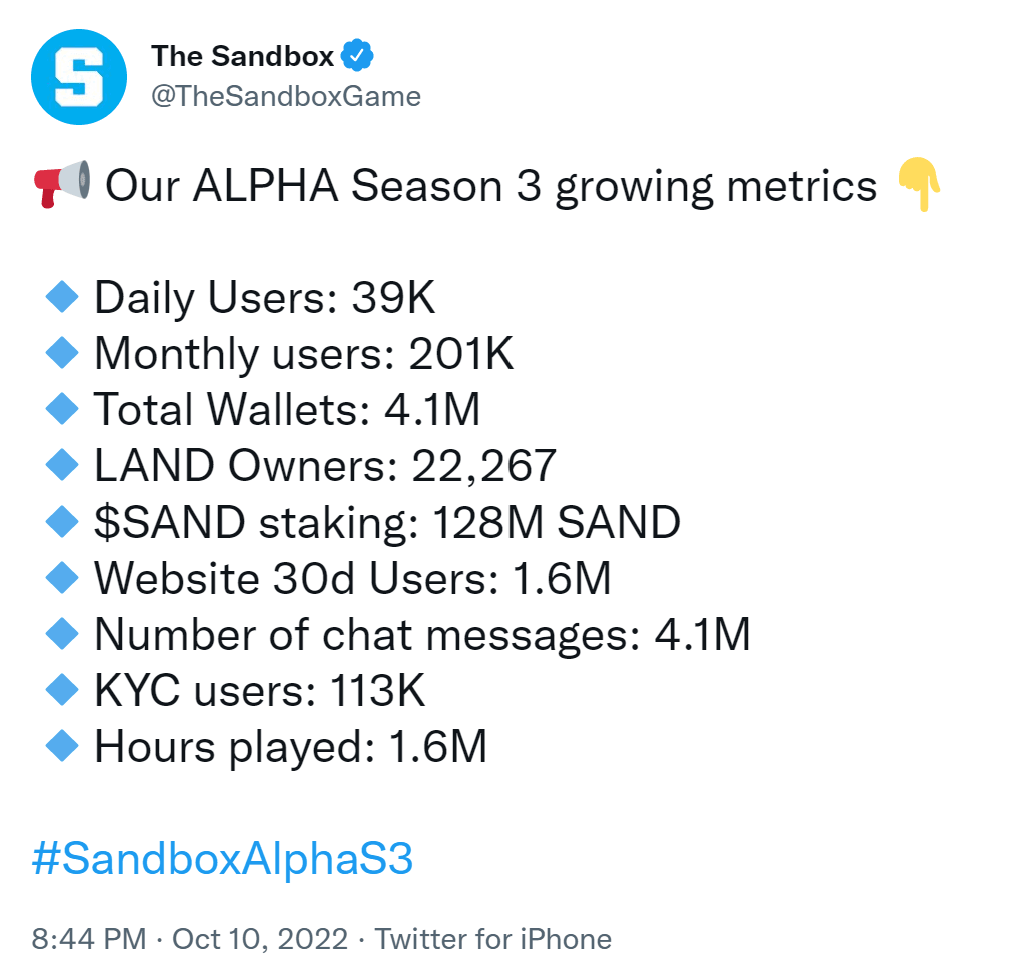

Over 140,000 NFT owners from top NFT collections such as Bored Ape Yacht Club, World of Women, CoolCats, Clone X, and Aoki voxels were available to utilize their digital assets from Web3 communities as avatars in The Sandbox Alpha Season 3. This is a very tangible example of interoperability in Web3.
The team designed a game that is even easier to play than previous Alpha Seasons in the spirit of the industry coming together. It invites the average user to go a step further and consider The Sandbox a game whose environment is only enhanced by blockchain technology. And contrary to appearances, this is highly useful.
Adoption is a typical topic for individuals who operate in the dapp industry. And for those who are seeking business opportunities in the cryptocurrency industry. Regardless of how cutting-edge the information and mentality underpinning blockchain technology may be, nothing (or very little) matters if it cannot be used by those who stand to benefit.
Compared to other cryptocurrencies, metaverse tokens have struggled since the beginning of the crypto winter. The weak market exposed vulnerabilities in early play-to-earn models, where most players’ profits were derived from speculation and inflation of the reward tokens.
Since November’s peak in the crypto space, the MVIS CryptoCompare Media & Entertainment Leaders Index is down 85% compared to Ethereum’s 71% drop. Furthermore, DeFi leaders’ had an 80% decrease, while infrastructure leaders’ experienced an 80% decrease. Since June’s low, performance has improved, but metaverse coins have frequently been one of the most volatile sectors we track, indicating a lack of investor faith in the ultimate winning concept.
Yuga Lab’s token APE has lost 72.92% since May 1st, hitting $5.44 on September 30th, with a market capitalization of $1.42 billion. The Sandbox coin SAND is the second metaverse project in market capitalization and followed the same downward trend as other leading metaverse tokens.
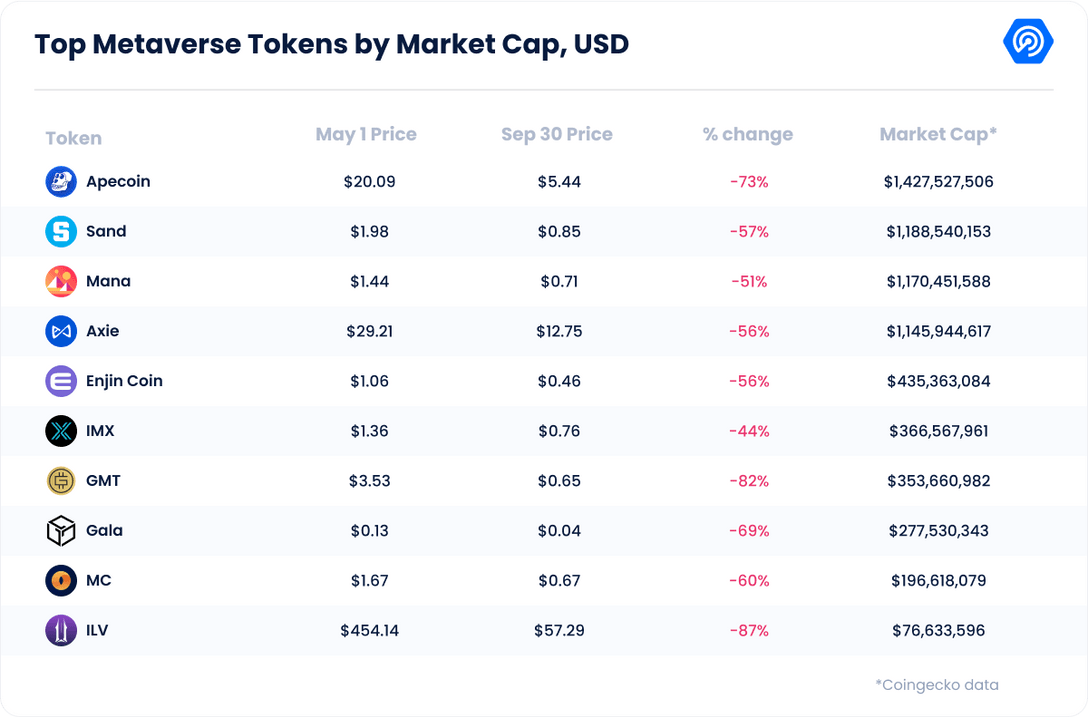

ImmutableX coin (IMX) is the sole gaming token that has decreased by less than 50% since May 1st. This remarkable accomplishment resulted from the various collaborations the gaming-oriented Layer-2 platform formed over the last three months. Read here about the most recent partnership.
The case of ENS is also worth highlighting. The governance token for the Ethereum Name Service DAO has experienced a decline of only 24% in the same timeframe. At the time of writing, ENS is worth $19.40, maintaining its May levels despite the crash.
Demand for ENS domains soared 72% in Q3
Blockchain naming systems such as the Ethereum Name Service (ENS) constitute an important part of the metaverse. Web3 domains provide us with a name in the metaverse, which is part of our digital identity. In September, users of the ENS registered 437,365 new ‘.eth’ domains, surpassing the previous record of 378,805 established in July.
The surge caused the overall number of registrations to increase to more than 2.6 million, while revenue from registration and renewal fees increased by $5.5 million. Protocol earnings are deposited into the project’s treasury for usage by the ENS DAO.
In September, ENS also documented 35,427 new accounts that registered or purchased at least one domain, increasing the total number of such accounts to 572,000. During the same time period, 97% of Web3 domain trading volumes on the top NFT marketplace OpenSea came from the ENS Domains collection. This also shows that ENS dominates the naming services by an significant margin.
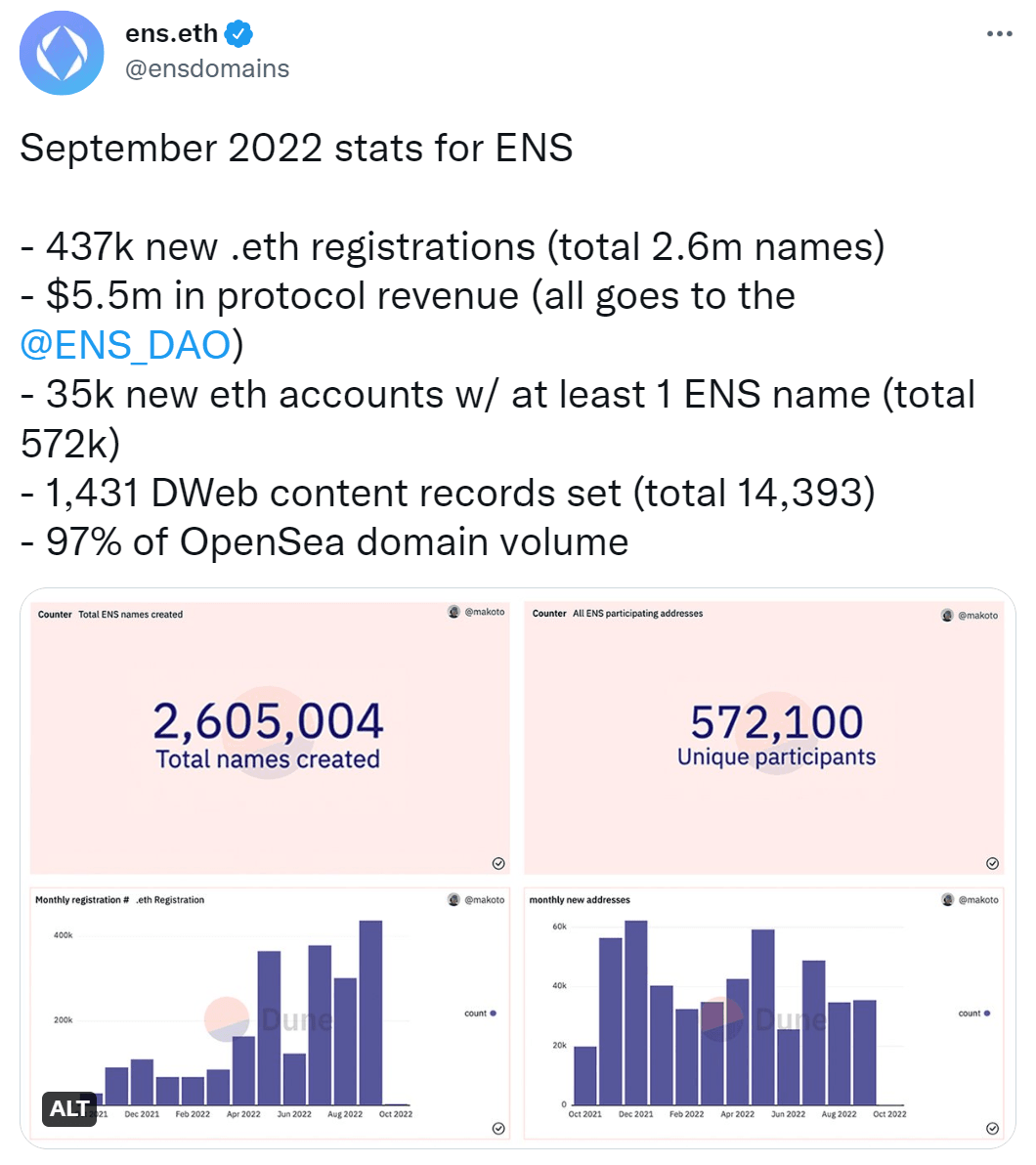

The record-breaking month was characterized by notable collaborations and sales. ENS, which is decentralized and built on the Ethereum network, teamed with Coinbase to establish unique cb.id crypto usernames to increase ENS adoption.
After working with Chain, the New England Patriots football franchise made its Web3 debut by acquiring ‘patriots.eth’ for 75 ETH, while Shark Tank investor Matt Higgins purchased many domain names for almost $100,000 in September alone.
During the last thirty days, the ENS governance token’s price chart remained stable. The coin achieved a monthly high of $16.33 on September 9th, according to CoinGecko, but failed to gain traction after that, closing the month at $16.02.
NameWrapper was introduced to the Goerli testnet by the group responsible for the Web3 domain service. NameWrapper is a smart contract encapsulating ENS domain names as ERC-1155 NFTs, allowing parent domain owners to specify permissions and rights for their subdomains and trade them on the market. Web3 naming services will become a popular category. For now, Ethereum-based names currently dominate the market; however, we can expect the trend to follow on different chains.
Despite the present bearish market, financing for metaverse and Web3 gaming ventures remains substantial. Up to this point in 2022, blockchain games and metaverse projects have raised about $7 billion, and even if the third quarter was the lowest in capital raises, we still managed to reach $1.2 billion.
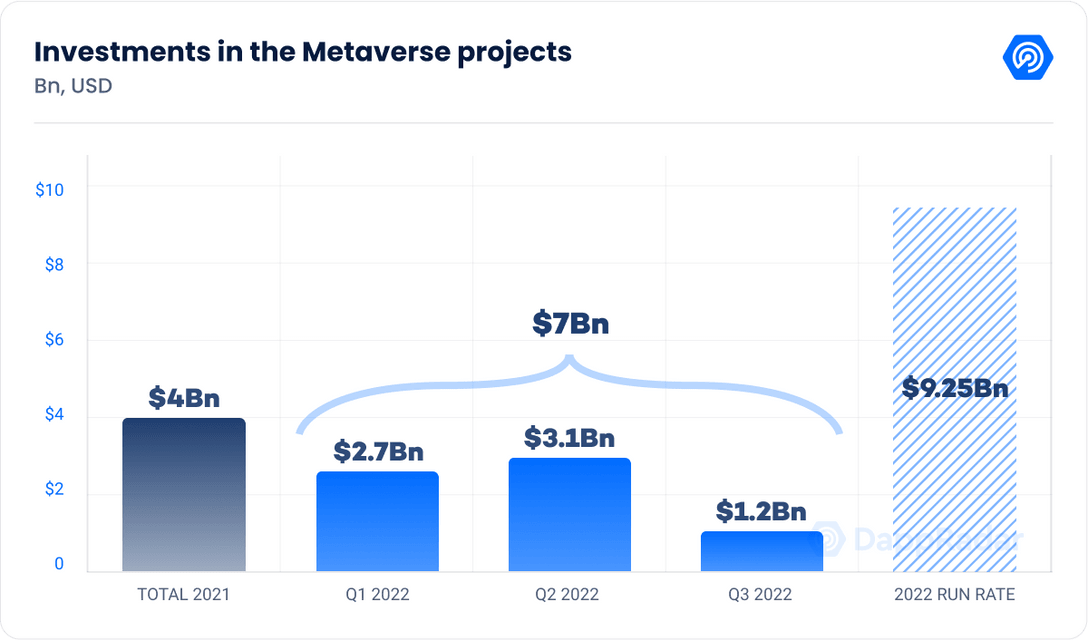

Looking at the investments made in the third quarter, we can see that blockchain games and metaverse projects have received the most funding, totaling 38.5% of the total. Infrastructure accounts for 33.5% of the capital raised, investment firms for 22.9%, and media and NFTs for the remaining 5%.
Despite this quarter’s low investment level, it showed that the sector never stops growing and that new major players are joining the market. In September, London-based deep tech startup Hadean raised $30 million to create a metaverse project.
Hadean has constructed critical metaverse components and partnered with entertainment, education, and business digital twin service providers (Minecraft, Pixelynx, Sony, and Gamescoin). This investment will help Hadean equip producers in new and expanding metaverse marketplaces to alter how people work, build, buy, and consume.
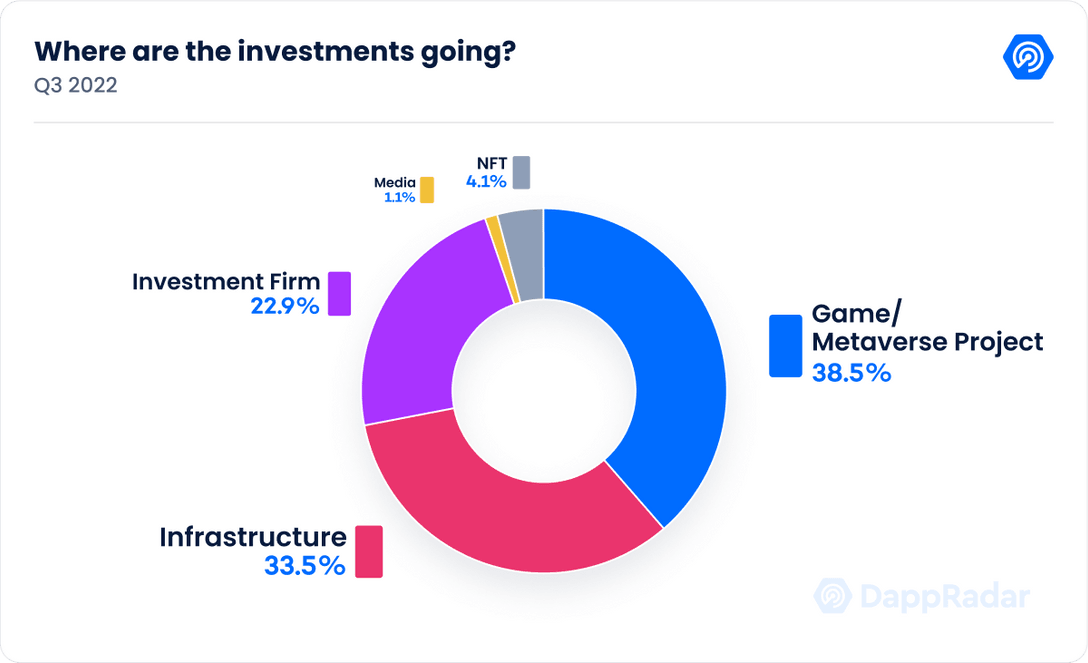

Blockchain technology, Web3, and the metaverse have the potential to disrupt the vast majority of industries. In recent years, venture capitalists and other professional investors have invested billions of dollars in blockchain startups. They believe Web3 will significantly alter our financial institutions, social connections, and identities.
This quarter has been extremely active in terms of metaverse adoption. In the 2022 Disney Accelerator Program, six “growth-stage” firms, including three Web3 companies — Layer-2 scaling platform Polygon, NFT AR social media app Flickplay, and startup Lockerverse — were selected to receive guidance. In addition, the corporation has been searching for a “corporate attorney” with knowledge of “emerging technologies” such as NFTs, the metaverse, and DeFi.
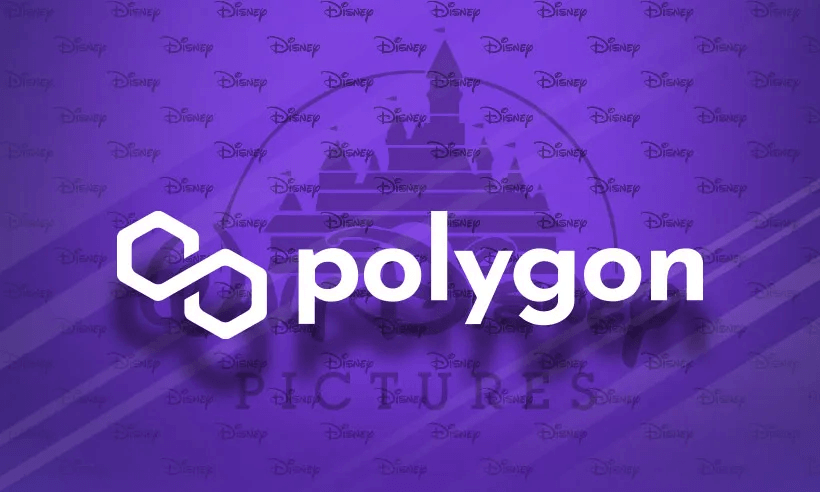

This may indicate that Disney is developing a strategy for utilizing the “virtual-world simulator” patent it filed with the United States Patent and Trademark Office in 2021. The application relates to using augmented reality (AR) technology in Disney theme parks and the possibility of a theme park metaverse.
The Flow blockchain also announced an interesting partnership with Ticketmaster. After successfully issuing 70,000 NFT tickets for Super Bowl LVI, Dapper Labs announced its collaboration with the world’s leading ticketing platform.
Walmart is yet another big brand to enter the metaverse. The retail giant debuted two virtual experiences on Roblox: Walmart Land and Walmart’s Universe of Play.
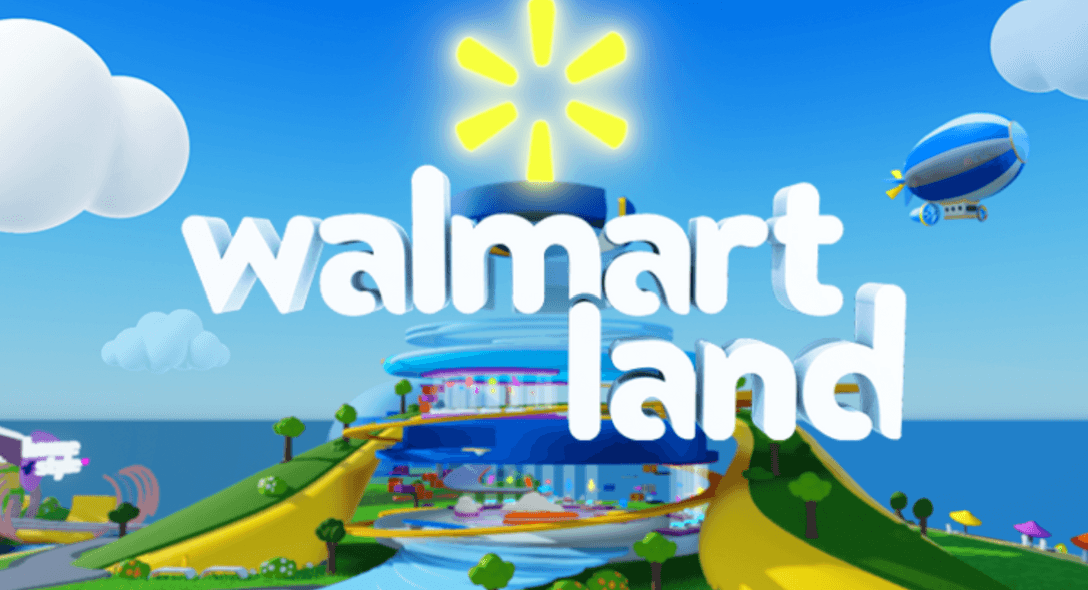

Walmart Land consists of a merchandise shop, a Ferris wheel, and minigames that reward players with tokens and badges. In October, it also intends to host a music event. The Universe of Play, on the other hand, aims to be a virtual toy store where users may acquire products and characters from franchises such as L.O.L. Surprise!, Jurassic World, Paw Patrol, Magic Mixies, and Razor Scooters.
Ford Motor Company is the latest automobile manufacturer to prepare its debut into non-fungible tokens (NFTs) and the metaverse, filing 19 trademark applications for its key automobile brands. The trademark applications encompass apparel, virtual cars, trucks, vans, sport utility vehicles, and a projected online marketplace for non-fungible tokens.
The company also unveiled plans for “downloadable virtual goods,” mainly “computer programs” comprising auto components and accessories and clothes for usage in “online virtual environments”, such as virtual reality and augmented reality-based online trade exhibitions.
In addition, there are plans to develop an online marketplace to promote the “digital artwork of others” as well as “online retail shop services featuring non-fungible tokens (NFTs) and digital collectibles.”
Ford is not the first automobile manufacturer to enter the metaverse. Car makers, including Mercedes, Nissan, Toyota, and Hyundai, have indicated expansion intentions into the fast-expanding metaverse market, while Bentley and Lamborghini have already released NFT collections.
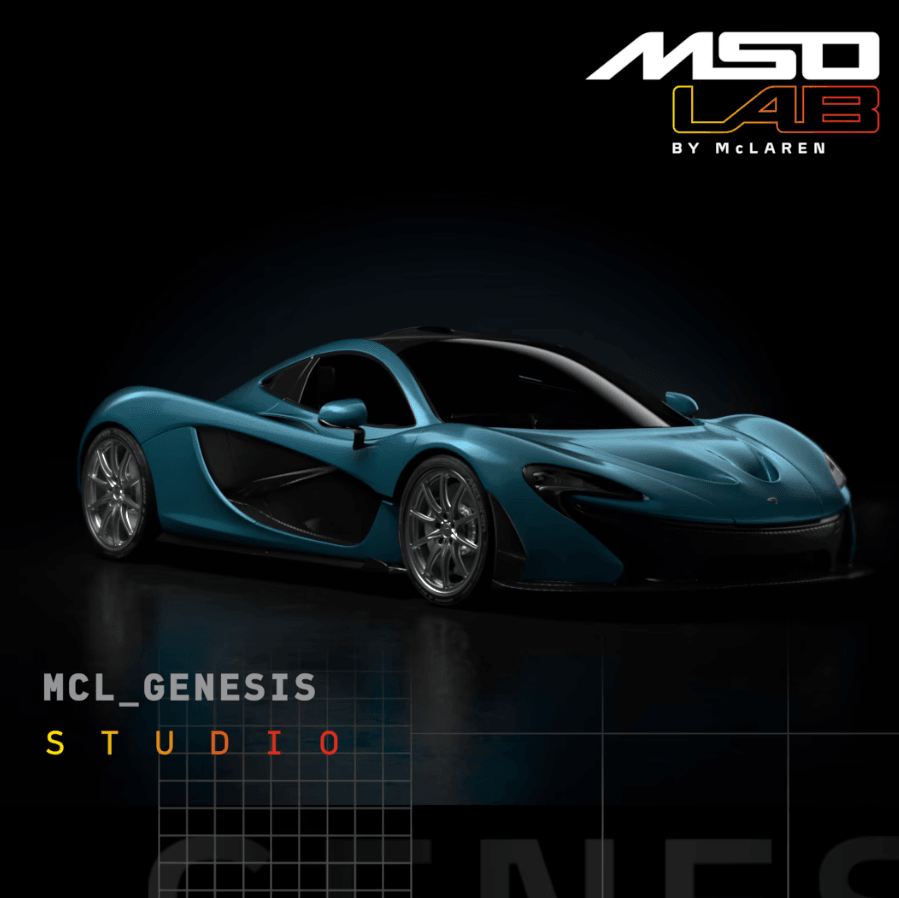

This quarter has also seen government adoption, especially notable in Asian economies. South Korea announced an investment of more than 223.7 billion won ($177.1 million) in several metaverse projects. To begin with, the national fund would be used to construct a metropolitan-level metaverse platform that would enable individuals to access various government programs and services digitally.
Prime Minister Fumio Kishida of Japan stated in a policy speech on October 3rd that the nation’s intentions for investing in digital transformation include non-fungible tokens (NFT) and metaverse services.
The nation has been progressively supporting investment in digital technology, particularly by offering tax benefits to businesses that embrace a digital future. In his address to the Japanese parliament, Kishida stated that the nation will continue to “help the social deployment of digital technology” and “encourage efforts to extend the use of Web3 services that leverage the metaverse and NFTs.”
The municipal government of Beijing has unveiled a two-year metaverse innovation and development strategy that focuses on fostering the growth of metaverse-related enterprises and assisting Beijing in becoming a benchmark digital economy city.
In the past few months, two large Chinese cities have unveiled multi-year action plans centered on the metaverse and NFTs. Before Beijing, Shanghai likewise incorporated the metaverse into its five-year growth plan, pledging to establish a 350-billion-yuan (about $51 billion) metaverse business by the end of 2025.
Beijing’s growing interest in cutting-edge Web3 technology could result in broader nationwide adoption. Previously, the Beijing Municipal Bureau of Economy and Information Technology issued a proposal for building a virtual human economy worth 50 billion yuan ($7.5 billion) over the next three years using Web3 technology.
The unfamiliarity and novelty of the metaverse are causing uncertainty. For this reason, Tony Parisi, the former Head of XR Ads and E-Commerce at Unity Technologies has defined seven rules for the metaverse.
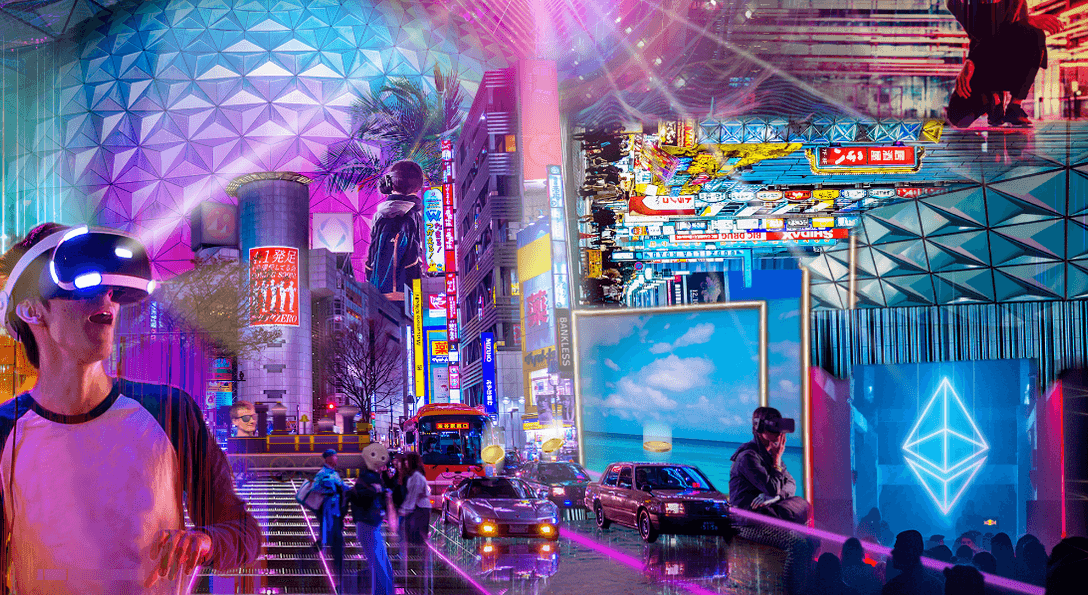

Rule #1. There is only one metaverse.
It is the total of all publicly accessible virtual worlds, real-time 3D content, and related media connected on an open global network, controlled by none, and accessible to all.
Rule #2: The metaverse is for everyone.
The metaverse is for everyone, as defined by our most general societal inclusion rules. This is not a political or socioeconomic statement; it is an ethnographic one with political and socioeconomic implications.
Rule #3: Nobody controls the metaverse.
It is the universal commons for digital communication and commerce, intermediated as needs dictate, governed as required for the common interest, toward the greatest good for the greatest number.
Rule #4: The metaverse is open.
It is built upon interoperable technologies and tools, connected via rigorously defined and broadly agreed-upon free and open communications standards.
Rule #5: The metaverse is hardware-independent.
The metaverse is hardware-independent and accessible on any device regardless of display type and device.
Rule #6: The metaverse is a network.
The metaverse is a computer network connecting the world’s publicly accessible virtual experiences, real-time 3D content, and related media.
Rule #7: The metaverse is the internet.
The metaverse is the internet, enhanced and upgraded to deliver 3D content, spatially organized information and experiences consistently, and real-time synchronous communication.
Conclusion
What exactly is the metaverse? What effect will it have? Consumers and organizations are investigating how it might enhance connectivity and improve daily life. And, within a decade, the metaverse could be the driving force behind a drastically different world.
According to McKinsey, it is feasible that by 2030, more than 50% of live events will take place in the metaverse. More than 80% of commerce could be affected by consumer actions on the internet, such as brand discovery and virtual store visits.
Most learning and development might occur in a metaverse setting, as well as the majority of virtual or hybrid cooperation. Virtually all assets and operations of asset-heavy firms, such as manufacturers and telecommunications companies, may be represented in a digital mirror. The same is true for the simulation of real items and spaces to aid in their creation. By 2030, Gartner anticipates that the average internet user will devote up to six hours per day to metaverse experiences.
Such generational shifts do not occur overnight. They typically take years and are the product of an accumulation of gradual breakthroughs driven by an experimentation-based philosophy on platforms that foster creativity.
Stakeholders have the chance to create the metaverse in a manner that promotes greater social cohesiveness, reduces inequality, expands access to education, and serves as a catalyst for social mobility.
The metaverse should not replace the physical world or the interpersonal bonds that unite us. It should complement what people do and, like virtual and physical workplaces, permit unrestricted mobility between the two worlds in a manner that broadens rather than restricts our range of experiences. For this to occur, however, collective leadership is required to ensure that the acts done responsibly shape the course of this revolution.
With the potential to generate up to $5 trillion in value by 2030, the metaverse seems unavoidable. It will have a significant impact on our business and personal lives. Something clear if you watched the Meta Connect event last week.
Therefore businesses, policymakers, consumers, and citizens would do well to investigate and learn as much as possible about this phenomenon, the technologies that will underpin it, and the effects it will have on our economies and society.
- Bitcoin
- blockchain
- blockchain compliance
- blockchain conference
- coinbase
- coingenius
- Consensus
- crypto conference
- crypto mining
- cryptocurrency
- DappRadar
- decentralized
- DeFi
- Digital Assets
- ethereum
- machine learning
- non fungible token
- plato
- plato ai
- Plato Data Intelligence
- PlatoData
- platogaming
- Polygon
- proof of stake
- W3
- zephyrnet



